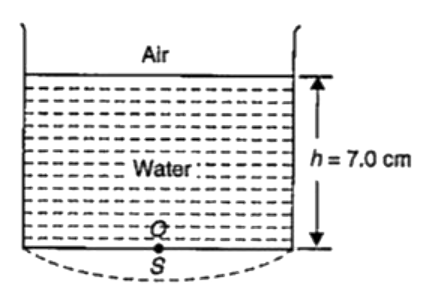Glycerine (μ=1.4) is poured into a large jar of radius 0.2m to a depth of 0.1 m. There is a small light source at the centre of the bottom of the jar. Find the area of the surface of glycerine through which light passes.
0.0327m2
Topper's Solved these Questions
- RAY OPTICSBOOK - AAKASH SERIESCHAPTER - RAY OPTICSEXERCISE - PROBLEMS ( LEVEL-II)
50 Videos
- RAY OPTICSBOOK - AAKASH SERIESCHAPTER - RAY OPTICSEXERCISE - PROBLEMS ( LEVEL-II)
50 Videos
- PRACTICAL PHYSICSBOOK - AAKASH SERIESCHAPTER - PRACTICAL PHYSICSEXERCISE - LECTURE SHEET LEVEL-II (ADVANCED) Linked Comprehension Type Questions
6 Videos
- SEMICONDUCTOR DEVICESBOOK - AAKASH SERIESCHAPTER - SEMICONDUCTOR DEVICESEXERCISE - EXERCISE - II
31 Videos
Similar Questions
Glycerine (refractive index 1.4) is poured into a large jar of radiys 0.2m to a depth of 0.1m. There is a small light source at the centre of the bottom of the jar. Find the area of the surface of glycerine through which the light passes.
View SolutionA liquid of refractive index 1.5 is poured into a cyclindrical jar of radius 20 cm upto a height of 20 cm. A small bulb at the centre of bottom glowing. Find area of the liquid surface through which the light of the bulb passes into air.
View Solution
Knowledge Check
Sun light is diffracted through a circular aperture of diameter 0.1μm. If diameter is slightly increased then
ASize of circular fringe will increase intensity decreaseBSize of circular fringe will increase intensity increaseCSize of circular fringe will decrease intensity decreaseDSize of circular fringe will decrease intensity increase
A liquid of refractive index 1.5 is poured into a cyclindrical jar of radius 20 cm upto a height of 20 cm. A small bulb at the centre of bottom glowing. Find area of the liquid surface through which the light of the bulb passes into air.
View SolutionA point source of light is 80.0cm below the surface of a body of water. Find the diameter of the circle at the surface through which light emerges from the water.
View SolutionA point source of monochromatic light .S. is kept at the centre Cof the bottom of a cylinder, Radius of circular base of the cylinder is 15.0 cm. The cylinder contains water (refractive index =43 ) to a height of 7.0 cm (see figure)
Find the area of water surface through which light emerges in air.

View SolutionA point source of monochromatic light 'S' is kept at the centre of the bottom of a cylinder of radius 15.0cm. The cylinder contains water (refractive index 4//3) to a height of 7.0cm. Draw the ray diagram and calculate the area of water surface through which the light emerges in air.
View SolutionA point source of monochromatic light 'S' is kept at the centre of the bottom of a cylinder of radius 15.0cm. The cylinder contains water (refractive index 4//3) to a height of 7.0cm. Draw the ray diagram and calculate the area of water surface through which the light emerges in air.
View SolutionA metal sphere of radius 1 mm falls vertically in glycerine Find the viscous force exerted by the glycerine on the sphere when the speed of the sphere is 1cm−1 For glycerine . η=8.0poise .
View SolutionA small coil of radius 0.002 m is placed on the axis of a magnet of magnetic moment 105 JT−1 and length 0.1 m at a distance of 0.15 m from the centre of the magnet. The plane of the coil is perpendicular to the axis of the magnet. Find the force on the when a current of 2.0 A is passed through it.

View Solution
